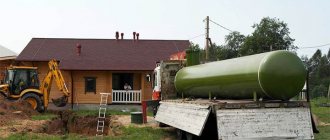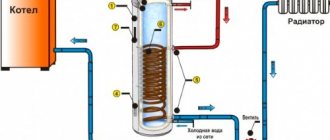In the modern world, living without gas in the house is quite difficult. Electric heating is much more expensive, and solid fuel boilers are not suitable for everyone. The most convenient heating is gas, so most people use it. But there are still places in the country where centralized gas supply has not yet reached. These are remote villages, some holiday villages.
An alternative to centralized gas supply is a gas holder. But not many people know what a gas tank is - it is a system that provides people with natural gas year-round in those places where it is impossible or very expensive to supply centralized gas. Thanks to a gas holder for a private home, many people have experienced the benefits of civilization and additional comfort in life.
The prices for gas tanks for a country house can be quite significant, but such tanks pay off over the years, because the cost of natural gas is constantly growing and can change greatly throughout the year. Such systems are becoming increasingly popular, so we will take a closer look at the gas tank - what it is, how much it costs and how to install it. To get first-hand information, we turned to the specialists of ROSAVTONOMGAZ, a company that occupies one of the leading positions in the autonomous gasification market.
Gas tanks Source rosavtonomgaz.ru
What is a gas holder: general information
A gas holder is a container designed for long-term storage of natural gas or other gaseous substances (biogas, liquefied petroleum gas, air, etc.), but for heating purposes the tanks are filled with liquefied propane-butane. Gas holders are used both on an industrial scale and for private use.
This autonomous system is a large reservoir for storing gas reserves, which allows you to not depend on the state and independently regulate the amount of utility bills for gas supply. By refilling the container once or twice a year, depending on the volume of the tank, you can safely use a gas stove for cooking and heat the house.
Gas tanks vary in volume - from 2500 to 20,000 liters; small tanks are used for mobile gas tanks. Since these are devices that require increased attention, it is mandatory to install protective automation that monitors the gas pressure inside the tank, controls the distribution and amount of fuel, and is also responsible for the safety of the autonomous system. The gas holder, the photo of which is shown below, can provide gas to a large private house.
Horizontal gas tanks of large volumes Source rosavtonomgaz.ru
Select the volume and calculate the costs
To choose the right gas tank, it is important to decide what volume it should be. This figure can be calculated taking into account gas consumption per 1 m2 of living space. In warm regions, consumption per 1 m2 averages 25-30 m3, and where it is cold - at least 35 m3. The need for gas can be calculated as accurately as possible by focusing on the power of the heating boiler - about 100 liters of fuel are consumed per 1 kW per year. You can also calculate the volume of the container in another way: if cylinders were used, then you need to estimate how many of them were spent per month and multiply the resulting number by 12.
How to position the gas tank correctly
Important! It is worth understanding that the cylinder is not 100% filled with gas. Approximately 15% of the volume must be free to allow gas to expand when heated.
The market for such equipment offers tanks of various volumes - from 2 to 10 thousand liters. It is important to choose a container that will need to be refilled no more than twice a year. For example, for a building with an area of 100 m2, a gas holder with a capacity of 2700 liters is sufficient . A tank with a volume of 10 thousand liters is suitable for a house of 300 m2.
Table of the ratio of the heated area and the optimal volume of the gas holder
The cost of gas is low, but it is important to understand that when refueling equipment you will have to immediately pay for a large volume. So, in the spring, gas costs less (about 15 rubles per liter), in the winter it gets a little more expensive - up to 20 rubles, because the demand for it grows at this time of year. That is, to refill a 4800 liter gas tank you will have to spend at least 58,000 rubles. in spring, and in winter - all 80,000 rubles.
Advice! If possible, it is better to choose a gas tank in such a way that you do not need to fill it often and fill it during the period when gas is the cheapest.
How else can you choose the volume of a gas tank?
The operating temperature range for the equipment is -40 – +40 degrees. But for a reservoir that will be located underground, these data are not critical - such indicators are not found in the ground. But if the system is installed incorrectly in winter, the gas supply may stop (this is due to freezing of the communications supplying gas to the house).
Prices for gearboxes for gas tanks
Reducer for gas tank
Types of gas tanks
Gas tanks have been used for private use for decades. Previously, they were very large, cylindrical structures with adjustable heights and were used to supply gas to entire areas in cities. Such systems are called gas holders of variable volume, and in some cities such buildings have been preserved to this day, albeit as museum exhibits.
What is a gas holder for a private home today? Modern versions of tanks are used mainly for gasification of private houses, summer houses, country cottages and have a more compact shape. They have a constant volume, are made of very durable metal and can be either vertical or horizontal. In addition, gas tanks are divided into above-ground and underground.
Installation of an underground gas tank Source rosavtonomgaz.ru
Ground. Installed on the surface of the land. A gas holder for a ground-based private house is advantageous in that the tank is easier to maintain and it is much easier to detect corrosion or other changes and breakdowns. But we should not forget that with such an installation in winter, the evaporation ability of the air-gas mixture drops sharply; in addition, the ground version of the tank requires additional safety measures.
Ground-based small gas holder Source rosavtonomgaz.ru
First of all, you need to make sure that the container is not exposed to direct sunlight. Despite the fact that the tank body is designed to withstand high temperatures, for additional safety it is better to install the gas holder in the shade.
In order to significantly save space on the site, when choosing a ground-based gas tank, preference is given to vertical type tanks with a small volume, which are connected into a single network. From the point of view of operation, a vertical gas tank is in no way inferior. The photo below shows horizontal and vertical containers of different volumes.
Vertical and horizontal gas tanks Source resant.ru
Underground. At first glance, the underground installation of a gas tank is associated with additional costs, which consist in the need to attract special equipment. But the underground location of the system provides protection from the cold, additional safety and constant, even gas pressure.
To prevent freezing of the tank and avoid mechanical damage, underground gas tanks are buried to a depth of at least 60 cm. As for the volume of the tank, on the site of a country house or private house you can easily place a tank with a volume of 2500 to 10000 liters, and the gas tank will not spoil its appearance landscape design.
The tank is buried in the ground so that only the neck remains on the surface, to which the filling unit is connected. Gas enters the house through pipes running from the unit to the building.
Vertical underground gas tank at the installation stage Source teplowood.ru
See also: Contacts of construction companies that offer house insulation services.
Vertical. They are very similar to huge cans, and differ from horizontal ones in that they take up relatively little space on the site. But with high gas consumption, such tanks are additionally equipped with evaporators, which help provide the consumer with the required gas pressure. This makes installation noticeably more expensive and increases operating costs.
Thus, a vertical tank is only beneficial if the gas is used for cooking and providing the home with hot water in the summer, when relatively little is required. It should also be taken into account that vertical gas tanks are most often designed for underground installation, which means that high installation costs are added to low efficiency.
Installation of a vertical gas tank Source magniteknn.ru
Horizontal. They are considered the most common in our regions due to the fact that they have a large area for the evaporation of the so-called “liquid phase”. In the horizontal version of the gas tank there is always a sufficient amount of air-gas mixture, which is enough to ensure normal pressure at increased consumption. Therefore, to ensure proper evaporation, natural conditions are sufficient and no additional devices are required, and this is a big cost savings. Horizontal gas tanks are capable of providing sufficient pressure even in severe frosts. Only one drawback was found - installing such a tank will require a lot of space.
Installation of a horizontal gas tank Source rosavtonomgaz.ru
Mobile gas tanks
If the housing is not used constantly or there is not enough free territory to place a stationary device, it is reasonable to use a mobile gas holder. What are they and how are they used: this is also a gas supply device, only in small sizes, they are used as needed, for example during the summer season, and when it is not needed, it is simply stored.
Advantages:
- Such devices can provide gas to the premises during the summer season, and you can take them with you for the winter;
- It is possible to provide gas to several objects in turn;
- No special equipment or free territory on site is required for installation and assembly;
- Since the volume of a mobile gas storage is small (approximately 500-600 liters), its cost is correspondingly low.
All gas holders require registration with the relevant authorities and the mobile version is no exception.
Mobile gas tank or mini gas tank Source resant.ru
Problem 1: Gearbox freezes
Description of the problem: Freezing of the gearbox of an underground gas tank, which occurs when water enters from melting snow and subsequent frosts.
Detailed description and reasons: The reducer of a tank for storing liquefied hydrocarbons is designed to control and reduce the pressure between the gas tank and the gas pipeline. With its help, the nominal pressure value of 1.5-16 bar is reduced to 22-100 mbar. Its proper operation is the key to error-free operation of the boiler and the safety of the entire gas supply complex at home.
The gearbox design contains a movable membrane, supported by a spring. This membrane regulates the output pressure while responding to the input pressure. The gearbox housing also has a “breathing” hole, through which the membrane moves. Through this hole, water can get inside the device and turn into ice in cold weather. Freezing of water in the reducer disrupts or completely blocks the operation of the gas storage reducer.
This can happen for various reasons:
- Wrong choice of gas tank. The buyer, due to savings or other considerations, chose a model with low pipes. And the level of groundwater or the amount of precipitation ensures their intensity in much larger volumes than predicted;
- Errors in container installation. The underground installation of the tank was carried out at a greater immersion depth than required.
- Formation of ice from water vapor in the composition of hydrocarbons with which the gas tank was filled.
Solution to the problem: Obviously, the solution to the problem of gearbox freezing is directly related to its cause. Having identified it, it is worth taking the appropriate actions:
- If you know that the area often floods, when purchasing a gas tank, you should choose models with high pipes. If the container has already been purchased, you can replace the reducer with a version with a high tube. It is more expensive, but at the same time more reliable in operation. If it is not possible to do this promptly (it is still necessary to heat your home almost constantly in winter), it is worth returning the current gearbox to operation. To do this, you need to remove it, warm it up, drain off any remaining moisture and dry it. You can gently heat it with boiling water, making sure that this does not become a new source of water in the fittings. But it is more effective to wrap it with a heating cable and warm the fittings until spring;
- Control the installation process. If the problem has already been identified, it is worth raising the capacity under the warranty provided by the company performing the installation work;
- Use high-quality LPG from reliable suppliers with good reviews. Also perform condensate pumping in a timely manner, with the regularity recommended by specialists.
Principle of operation
The principle of operation of a gas tank is quite simple: gas is pumped into a tank, and due to the fact that the tank is not completely filled, an air-gas mixture (propane-butane) is formed in the empty space of the storage. In order for the natural evaporation process to take place effectively, several rules should be followed:
- Do not fill the container with liquefied gas more than 85%.
- When installing a tank, it is necessary to strictly take into account that it should not be cooled below 0°, therefore, if a ground-based gas tank is installed, it will need to be insulated.
- If it is assumed that the evaporation area will be small (for example, in vertical containers), then it is necessary to consider an additional system of evaporators.
The gas mixture enters the house through a pipeline, just like through a regular pipeline. The gas tank is filled by specialists working on a machine with a filling tank. The procedure itself is reminiscent of refueling a car at a gas station.
Safety
Despite the advantages of an independent gas supply, owners of private houses are worried about the idea that a flammable fuel storage facility will be located next to their home. It is not enough just to observe the required distances during installation - you must adhere to the rules for refueling and servicing gas tank equipment.
Mandatory safety rules:
- Maintaining a constant supply of gas - approximately 25% of the volume. When the fuel is completely exhausted, a vacuum is formed inside the storage facility; during the next refueling, its technology is disrupted, which can lead to an explosion.
- Filling the gas tank should only be carried out by a specialized company. Small savings due to inviting unqualified gas workers privately will not cover the costs of eliminating the consequences of the fire.
- Safety valve control. Periodic inspections and troubleshooting help prevent emergency situations.
- Preventing leaks. The leaking propane-butane mixture weighs more than air, so it spreads over the surface of the earth.
The risk of fuel leakage is high due to physical damage to the walls, faulty shut-off valves, unqualified repairs or refueling, or leaking joints between parts of the gas distribution system.
Mandatory safety measures include the installation of grounding and lightning rod systems. It is prohibited to make fires or perform welding work in the immediate vicinity.
Video description
For more information about the gas tank and its installation, watch the video:
To control and regulate the process, the system has special automation; if you need to shut off the supply, you just need to turn a special tap. Excess pressure is removed using a special valve. The remaining gas is recorded thanks to a warning system that will warn the owner about the need to refill the tank.
Gas tank automation Source m.mitex-shop.ru
Problem 2: Flooding of the gas tank filler neck
Description of the problem: When checking the level of remaining fuel, it turns out that the filler neck and gearbox are flooded.
Detailed description and reasons: If this happens in the warm season without further frost, then most likely the fittings and other equipment will work properly. We talked about the consequences of gearbox freezing earlier. But if the water above the filling neck freezes, this makes it impossible to replenish the LPG level in the tank of the autonomous gas supply system.
Solution to the problem: The reasons and solutions are similar to the previous paragraph. In addition, to eliminate the possibility of flooding of the reinforcement as a result of melting snow, it is recommended to build an additional barrier to precipitation. For example, place it in a reinforced concrete ring with a lid.
How to install a turnkey gas tank
You need to order a turnkey gas holder for a private home only from a specialized company that has the necessary license. You cannot install a gas tank with your own hands - it is illegal.
It is important! The supply of gas to the tank, refueling, connection of the gas holder to the gas boiler and all service work must be carried out only by certified workers from special companies. This is explosive equipment and requires proper maintenance by qualified technicians.
On a note! You can get professional advice on autonomous gasification of a private home directly from specialists
Various volumes of vertical and horizontal gas tanks Source brickandpress.com
Preparatory stage
To properly install the gas tank, you must first carry out preparatory work. All dimensions of the pit and its location relative to the building must comply with the standards and requirements for the installation of gas tanks.
- The pit should be 0.5 m larger than the size of the tank on all sides.
- A concrete slab with fastenings for the tank feet is placed at the bottom of the pit.
- The trench under the highway should not interfere with or intertwine with other communications.
- The depth of the pipeline trench must be at least 1.70 m, and the slope towards the house must be at least 5°.
- The distance to a residential building from the gas tank is at least 10 m.
Delivery of the gas tank to the site for installation Source rosavtonomgaz.ru
Device
Adjustment of gas consumption, the volume of its supply to a private house, and control of the remaining fuel in the storage facility is carried out automatically through distribution equipment. If necessary, the gas supply is also shut off manually.
Structurally, the gas tank is similar to a “barrel” made of sheet metal. The outer surface is painted in several layers of epoxy paint, which protects the structure from corrosion and gives additional strength.
Filling the container with fuel is carried out through the neck located in the upper part of the body. The higher the neck is, the less likely the gas tank is to flood during the season of heavy rainfall and active snow melting. This is especially important for private homes located in areas with harsh climates.
Gas tank installation
Equipment and work processes are controlled using shut-off and control valves. The composition of the kit for different models may vary, but even the simplest tanks are equipped with:
- valve for condensate drainage;
- a sensor indicating the filling level of the container;
- filling valve;
- reducer for setting operating pressure parameters;
- safety valve;
- pressure gauge.
Expensive models provide for the installation of automation with program control and high-precision electronic pressure gauges.
Shut-off and control valves
Video description
For more information about autonomous gasification, watch the video:
If you want to buy a mobile gas tank, its price will be much cheaper than usual, and it will not require installation on site.
How to calculate the volume of a tank for a private house
Bigger does not mean better, so you need to calculate the volume of the gas tank correctly. This is done based on the technical characteristics of the heating boiler, the area of the house, and the number of cooking surfaces.
Horizontal gas tanks are selected with a margin of 15% of the calculated consumption indicators, and vertical ones with a margin of 10%.
Correct calculation of the tank volume allows you to choose a suitable gas tank for a private home; prices for them mainly depend on the volume, which means that you will not overpay for extra and unnecessary tank volume.
Installation diagram of a gas tank for heating a private house Source resant.ru
The cost of a gas tank and its installation
When choosing gas tanks for a private home, prices in the Moscow region can take a long time to review, since they depend both on the manufacturing company and on the volume of the tank itself. At first glance, everything is simple: the larger the tank, the higher the price, but the economic benefits of small storage facilities are sometimes deceptive. After all, a small tank needs to be refilled more often, which means additional costs for gas delivery. Therefore, you should choose a gas tank after first calculating the volume of the tank required for heating the house.
If you have already chosen and purchased a gas tank, the cost of installation will be calculated specifically for you by a specialist who comes to the work site. Typically, prices vary depending on the distance of the site from the city where the installation will take place, the size of the tank and its type, as well as the length of the gas pipeline. The cost of installation can vary from 40,000 to 100 thousand rubles. This includes everything (earth and installation work, reinforced concrete slab, set of materials, delivery), except the cost of the gas holder itself.
Installation of two gas tanks for heating a private house Source svoigaz.ru
How many gas cylinders can a private owner carry in a car?
This is perhaps one of the main questions when it comes to homemade products from gas cylinders. Let's turn to the laws.
The transportation of dangerous goods in the Russian Federation is regulated by the following documents:
- “Rules for the transportation of dangerous goods by road”
- "European Agreement concerning the International Carriage of Dangerous Goods by Road"
- "Traffic Laws"
- “Code of the Russian Federation on Administrative Offenses”, Article 12.21 Part 2 of which provides for liability for violation of the rules for transporting dangerous goods in the form of “an administrative fine for drivers in the amount of one to three times the minimum wage or deprivation of the right to drive vehicles for a period of one to three times the minimum wage.” three months; for officials responsible for transportation - from ten to twenty minimum wages.”
But “The Rules do not apply to the transportation of a limited amount of dangerous substances in one vehicle, the transportation of which can be considered as the transportation of non-dangerous cargo.”
From here, we look in the table to see how many gas cylinders are not dangerous for transportation by private individuals and intended for personal use .
It turns out that 15 pieces are allowed to be transported without permission. gas cylinders of 50 l.











